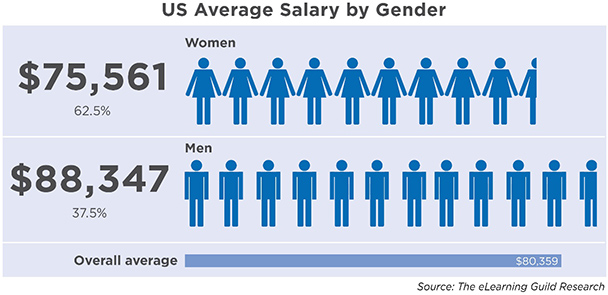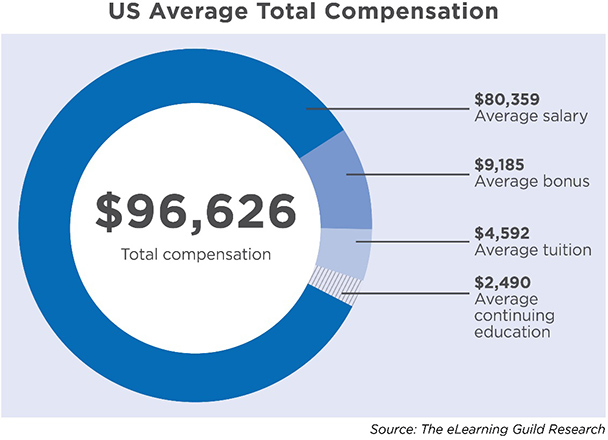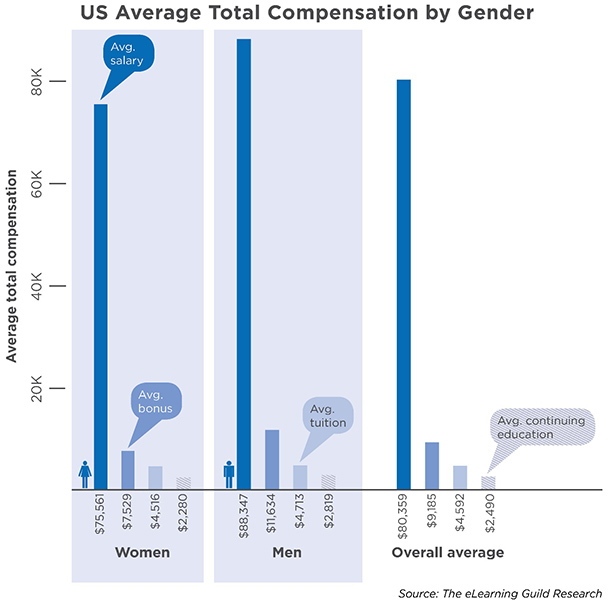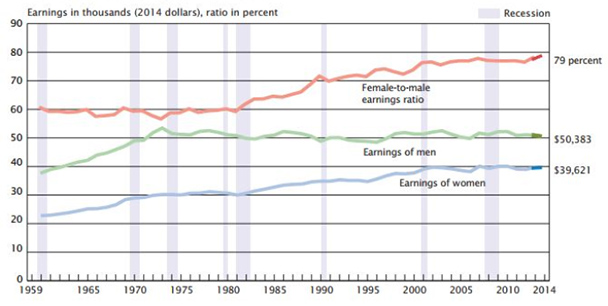With publication of the 2016 US eLearning Salary & Compensation Report, the gender pay gap continues to be a highly controversial topic, as it was for last year’s report. When we did our 2015 survey, a large number of salary report readers said they wanted more commentary and research about gender pay differences in a future report, while others said gender was not an issue for them and they did not want more discussion of that topic.
Our sense was that we should include more research and information about this important topic in this year’s report and other Guild publications. In this follow-up to our 2016 salary report, we focus on additional information regarding the US gender pay gap.
Gender and pay demographics
First, a few basics. Our analysis of gender and salary variables for 2015 was based upon the following demographics:
- Of this year’s grand total of 4,488 global respondents, 3,536 were United States respondents. In other words, 78.8% of all responses received were from the US.
- Of this year’s total of 3,536 US respondents, 1,327 (37.5%) were men.
- Of this year’s US respondents, 2,209 (62.5%) were women.
US average base salaries and gender
Regarding US salaries by gender (Figure 1), we found that the average salary for US men who participated in the 2016 survey is $88,347, while the average salary for 2016 US women participants is $75,561.

Figure 1: US average salary by gender
Given the US average base salaries shown in Figure 2, the average base salaries for US women are nearly 14.5% less than for the US men who participated in this study. The average US base salary for all study participants, regardless of gender, is $80,359.
US average total compensation and gender
This year’s data provided us with an overall view of the US average total compensation (Figure 2).

Figure 2: US average total compensation
Based on these data, the US average base salary has dropped by 0.89% since last year, from $81,079 to $80,359.
The US average bonus is $9,185. This US average is almost exactly in line with this year’s global bonus average of $9,036. (See the complete salary report for more discussion of merit-increase timing as this relates to average amount of bonus.)
The US average tuition reimbursement amount is $4,592, and the average continuing education reimbursement amount is $2,490. Some companies offer both benefits; others, only one of the two. Keep in mind that the Internal Revenue Service has strict rules governing these types of benefit programs as well as an annual dollar limit of $5,250 (see References).
Now, let us look at US average total compensation data by gender (Figure 3). We again see the 14.5% gap in total base salary and an even wider gap of 35.3% in average bonus amounts. The gap between women’s average tuition reimbursement ($4,516) and men’s ($4,713) is relatively small at 4.2%. We see another gap between women’s average continuing education reimbursement ($2,280) and men’s ($2,819), but this time, the gap between the two reimbursement amounts is substantially larger at 19.1%.

Figure 3: US average total compensation by gender
The gender pay gap controversy
It may come as a surprise to some that there are strong opinions about the existence of what is called the “gender pay gap.” Our purpose here is only to frame the controversy and suggest some additional reading so that readers can form their own opinions on the matter.
Viewpoint: The gender pay gap is real. The American Association of University Women defines the pay gap as follows: “The difference in men’s and women’s median earnings, usually reported as either the earnings ratio between men and women or as an actual pay gap. … The median value is the middle value, with equal numbers of full-time workers earning more and earning less.”
In a report (see References), the organization also states:
-
In 2014, women working full time in the United States typically were paid just 79 percent of what men were paid, a gap of 21 percent[.] The gap has narrowed since the 1970s … due largely to women’s progress in education and workforce participation and to men’s wages rising at a slower rate. But progress has stalled in recent years, and the pay gap does not appear likely to go away on its own.
Viewpoint: The gender pay gap is mischaracterized. In stark contrast, Hanna Rosin reported on “The Gender Wage Gap Lie” for Slate back in 2013 (see References), and said this:
-
How many times have you heard that “women are paid 77 cents on the dollar for doing the same work as men”? Barack Obama said it during his last campaign. Women’s groups say it every April 9, which is Equal Pay Day. In preparation for Labor Day, a group protesting outside Macy’s this week repeated it, too, holding up signs and sending out press releases saying “women make $.77 to every dollar men make on the job.” I’ve heard the line enough times that I feel the need to set the record straight: It’s not true.
The official Bureau of Labor Department statistics show that the median earnings of full-time female workers is 77 percent of the median earnings of full-time male workers. But that is very different than “77 cents on the dollar for doing the same work as men.” The latter gives the impression that a man and a woman standing next to each other doing the same job for the same number of hours get paid different salaries. That’s not at all the case. “Full time” officially means 35 hours, but men work more hours than women. That’s the first problem: We could be comparing men working 40 hours to women working 35.
Viewpoint: The gender pay gap is overblown. Consider this other viewpoint from Romina Boccia at the Heritage Foundation (see References):
-
At 78 cents on the dollar, the so-called wage gap represents the earnings ratio between male and female full-time median wage workers based on the Census Bureau’s 2013 Current Population Survey. If you divide the median earnings for women by those of men, you arrive at the wage gap. … When accounting for relevant factors that affect pay, such as education, choice of industry and occupation, hours worked, experience and career interruptions, the difference between average male and female wages shrinks to about 5 to 7 cents on the dollar. In other words, the earnings ratio between women and men becomes 93 percent to 95 percent after accounting for relevant differentials between individuals.
The gender pay message can be confusing
Not only are these viewpoints conflicting, but the statistical data and analytical interpretations reported in our national media can be confusing at best and misleading at worst. For example, in some analytical circles and news reports, the gender pay gap seems to be shrinking.
A case in point: In September 2015, Wall Street Journal writer Eric Morath reported, “The gender wage gap narrowed to the lowest level on record last year, but for every dollar a man earned women took home 21 cents less, on average” (see References). The article went on to say, “Women working full-time, year-round jobs earned 78.6% of what similar men did in 2014, according to a Census report.” As shown in Figure 1, “that’s the smallest gap on record back to 1960,” Morath writes. “The latest reading marks a narrowing from 77.6% in 2013, but the change is not statistically significant. In fact, the pay gap hasn’t changed meaningfully since 2007, when it was 77.8%.”

Source: The Wall Street Journal, September 16, 2015
Figure 4: Female-to-male earnings ratio and median earnings of full-time, year-round workers 15 years and older by sex: 1960 – 2014
The Wall Street Journal took a slightly less positive viewpoint in October 2015, when Morath reported, “The gender pay gap is widening again because men’s earnings are growing this year at twice the rate of women’s” (see References). Morath continues: “The median weekly earnings for full-time male workers was $889 in the third quarter, the Labor Department said. … That’s a 2.2% increase from a year earlier. Meanwhile, full-time female workers’ earnings were $721, up 0.8% from a year earlier.”
It can be a somewhat confusing message: In the first article, the newspaper reported that “the narrowing of the gap last year was largely a reflection of stagnant male earnings, rather than a robust increase in pay for women.” Then, just a month later, it concluded as follows: “The latest data marks the third straight quarter that the increase in male earnings was at least double that of female workers. As a result, women who work full time earned 81.1 cents for every dollar a man earned from July through September [2015]. That’s down more than a penny from a year earlier.”
Gender pay differences: where do we go from here?
If you believe that the status of gender pay and equality needs to be improved, you may have reason for optimism. Consider, for example, McKinsey & Company’s position on the “road ahead” for gender equality. A recent article in McKinsey Quarterly (see References) states:
To the extent that private and public institutions have made the necessary commitment from the top and are working to intervene in the ecosystem of change, we are confident they will, given time, reach their goal. Too many companies have yet to grasp the case for change, however, and still lack both commitment and a program of action. For these institutions, gender parity will take longer to achieve.
Regardless of current viewpoints on the issue of ongoing pay inequality for women, we believe that these different perspectives will persist for some time. As a result, it is incumbent upon all of us, as members of the workforce, to keep current on the latest statistics and to become more informed and critical readers of all published material on this subject.
References
2016 US eLearning Salary & Compensation Report
The eLearning Guild Releases 2016 Global eLearning Salary & Compensation Report
American
Association of University Women. The Simple Truth
About the Gender Pay Gap, Fall 2015 ed.
http://www.aauw.org/files/2015/09/The-Simple-Truth-Fall-2015.pdf
Barton, Dominic,
Sandrine Devillard, and Judith Hazlewood. “Gender equality: Taking stock of where we
are.” McKinsey Quarterly. September
2015.
http://www.mckinsey.com/insights/organization/gender_equality_taking_stock_of_where_we_are
Boccia, Romina. “Is There a Real
Wage Gap Between Men and Women?” The Daily
Signal. 14 April 2015.
http://dailysignal.com/2015/04/14/is-there-a-real-wage-gap-between-men-and-women/
Internal Revenue
Service. “Employer-Provided Educational Assistance.”
https://www.irs.gov/publications/p970/ch11.html
Morath, Eric. “The Gender Pay
Gap Widens as Men’s Earnings Grow Twice as Fast as Women’s.” Wall Street Journal. 20 October 2015.
http://blogs.wsj.com/economics/2015/10/20/the-gender-pay-gap-widens-as-mens-earnings-growtwice-as-fast-as-womens/
Morath, Eric. “Gender Wage Gap
Smallest on Record, but Women Still Earn 21% Less Than Men.” Wall Street Journal. 16 September 2015.
http://blogs.wsj.com/economics/2015/09/16/gender-wage-gap-smallest-on-record-but-women-still-earn-21-less-than-men/
http://www.slate.com/articles/double_x/doublex/2013/08/gender_pay_gap_the_familiar_line_that_women_make_77_cents_to_every_man_s.html

